Johnson County Museum’s new special exhibit, TRAINS: Transportation and the Transformation of Johnson County, explores ways the arrival of the railroad changed the county. One often overlooked way trains transformed Johnson County was in the sharing of ideas and information. While researching at the Kansas State Archives, museum staff came across a series of documents related to what was called a “special” train in the Atchison, Topeka and Santa Fe Railway Company Records. These documents illustrate that trains transported more than freight and people – they also transported ideas.
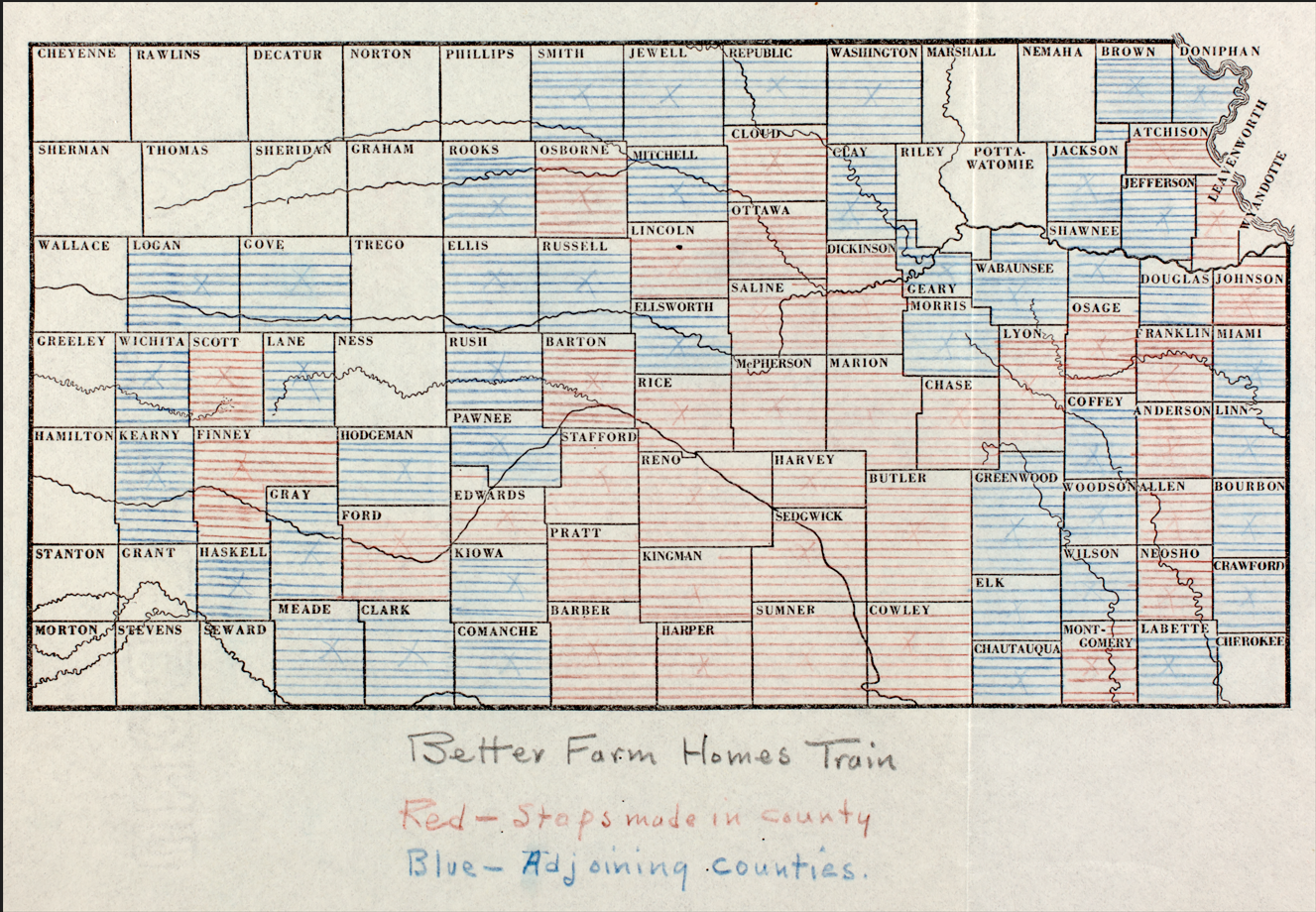
The Farm Homes Demonstration Train
In the early- to mid-20th century, much of the nation’s population lived in rural settings or small towns with limited access to national newspapers and radios. Various railroads sent out “specials” to share information on a variety of topics with people across the U.S.
By the 1930s a large portion of Johnson County’s population was engaged in agriculture. According to the 1930 Census, 37% of male working-age residents were farmers, and approximately one-third of all working-age Kansans were farmers. While many rural residents had been unable to afford remodeling or building new homes on their farms during the height of the Great Depression, a stabilizing economy meant that many were ready to do what they could to spruce up their older homes.
Francis D. Farrell, president of Kansas State College (K-State) and J. Frank Jarrell, manager of the Agriculture Development Department of the Atchison, Topeka and Santa Fe Railway (the Santa Fe) saw an opportunity to promote ideas for constructing, remodeling, and furnishing homes to farmers and other residents in Kansas. The pair planned a special demonstration train to reach Kansas’ farming families called the Better Farm Homes Demonstration Train. Throughout 1937, the train ran across Kansas spreading ideas to, as one press release stated, “help them [Kansans] in their home improvement problems.”
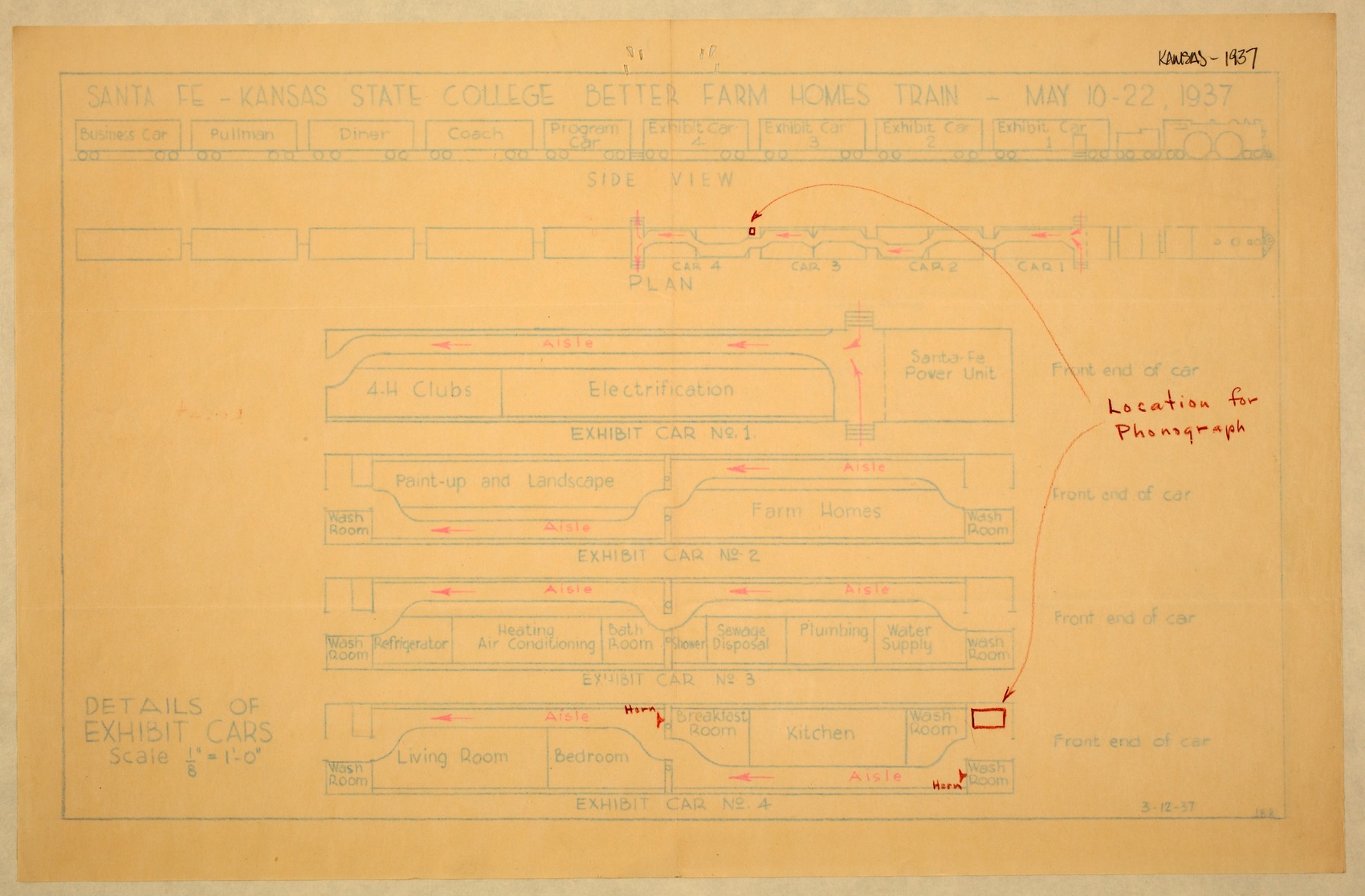
The Better Farm Homes Demonstration Train’s exhibits were promoted as being of interest “to the homemaker, to the farmer, and to the rural youth.” Those who attended the train’s programs saw house plans, landscaping suggestions, and interior décor and furnishings. Mechanical equipment advertised as “necessary to the modern home” included refrigeration, water supply and sewage disposal, plumbing, heating, air conditioning, electric lights, and power units. Attendees could also meet with “architects, engineers, interior decorators, and home furnishings specialists.” Additionally, 4-H Club representatives were on hand to talk with young people.
Criss-crossing Kansas
The demonstration train was scheduled to stop in 36 county seats across the state over a two-week period, from May 10 to May 22, 1937. Fliers, advertisements, and even letters sent to local newspaper editors, county extension agents, and presidents of local banks promoted the train. The person placing advance ads reported “the enthusiasm being shown by local committees and others who attended these meetings is unprecedented. I would forecast excellent crowds at the majority of the stops.”
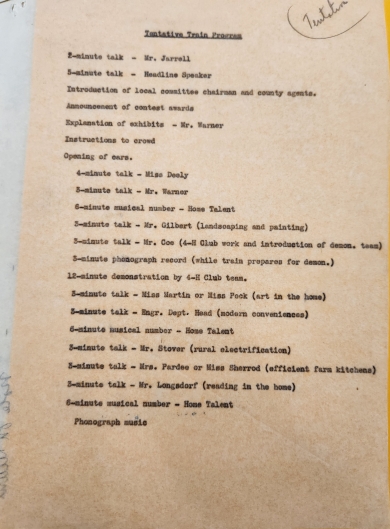
The special train consisted of a locomotive and nine rail cars. Four cars held demonstration materials – “electric appliances, farm conveniences, and home conveniences.” A flatbed car was used for outdoor lectures given by various speakers traveling on the train, and a coach was used for meetings and contests for young people. The remaining cars included a sleeper car, dining car, office car, and coach for the staff and “trainmen.” 28 people traveled aboard the train, representing K-State, the Santa Fe railroad, government personnel, trainmen, and several embedded reporters. The Santa Fe’s food provider, the Fred Harvey House restaurants, provided meals. The partnership between K-State and the Santa Fe was simple: K-State paid its people and covered the cost of the demonstration exhibits and any literature and advertisements it wanted to distribute, while the Santa Fe covered the cost of running the train, advance marketing materials, and the almanac it distributed to attendees.
Next Stop: Olathe!
The Better Farm Homes Demonstration Train stopped in Olathe from 7:30pm to 10pm on May 13, 1937. More than 2,000 people visited the train, which stopped six blocks from the depot to avoid blocking the main line. The sizeable crowd had opportunities to learn about the train in the Johnson County Democrat and The Mirror. The presidents of the Patrons Co-operative Bank and the First National Bank of Olathe also received letters promoting the demonstration train.

In addition to lectures, exhibits, and free educational material, the 2,000 visitors to the train in Olathe were treated to entertainment. Olathe’s itinerary included “local bands, bugle and drum corps, high school orchestra, window displays, model building contest, novelty feature entertainment, and women’s chorus,” and noted that “business interests are showing 100 per cent cooperation.”
“A Big Success”
Overall, the demonstration train’s reception was very positive. In a letter to a Santa Fe vice president dated May 24, 1937, the Santa Fe’s J. Frank Jarrell reported the train went without a single hitch in operations. Three days later, Jarrell wrote the train was “a big success.” K-State Extension records reveal more than 67,000 Kansans from 82 counties attended the 36 stops. Jarrell wrote to K-State’s Francis D. Farrell on June 4, saying, “the train apparently was a success in points of attendance, interest, program and beauty of the exhibits. I believe the people who attended the show found something on which they could begin building. The newspaper took fine care of the train. We have [collected] more than 1,265 items, all favorable.”
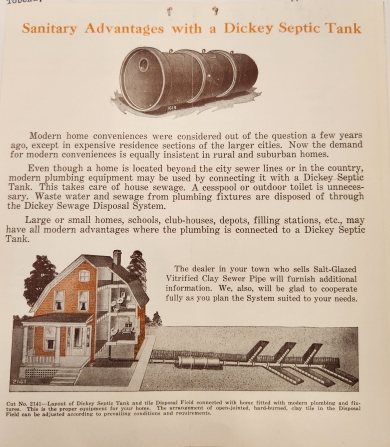
Accounts reveal the Santa Fe spent nearly $1,200 on advance newspaper ads – equivalent to just over $20,000 in 2019 money. Despite the train’s success, extension agency records indicate this was the last demonstration train to run in Kansas. Demonstration trains like the 1937 Better Farm Homes train were both a novelty and a norm. Special trains were themselves a novelty, a form of popular entertainment spreading new information and ideas to rural populations. Yet demonstration trains on various subjects and with differing purposes ran every few years in Kansas – 27 ran between 1905 and 1937 – and in other states in the Midwest and West. Without a train like the one that stopped in Olathe in May 1937, local farming families might never have learned about safer building techniques, sanitary improvements like septic tanks, or helpful and safer home technology like electric generators. Because of demonstration trains such as this one, the world was made a little smaller and its people a little more connected and better informed.
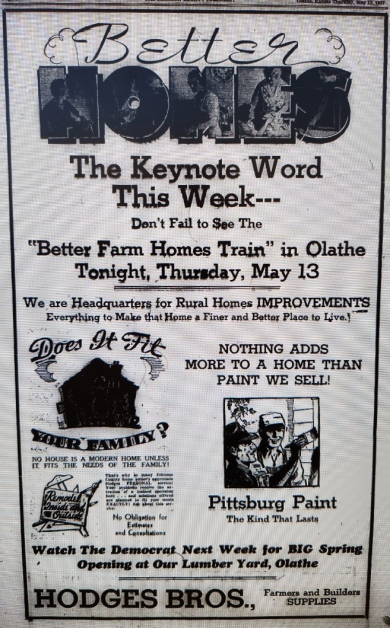
*** *** ***
The Johnson County Museum’s new special exhibit, TRAINS: Transportation and the Transformation of Johnson County, is now on display. It is included in regular admission, Monday through Saturday, 9am to 4:30pm. You can learn more and plan your visit at jcprd.com/Museum.
Want to visit the Johnson County Museum for free? There are several ways this summer. Check out jcprd.com/Museum to learn more about the Sunflower Summer program; Blue Star Museums; and mark your calendar for Sept. 16, our next quarterly Free Day!
*Title taken from a press release for radio spots for the 1937 Better Farm Homes Demonstration Train.
